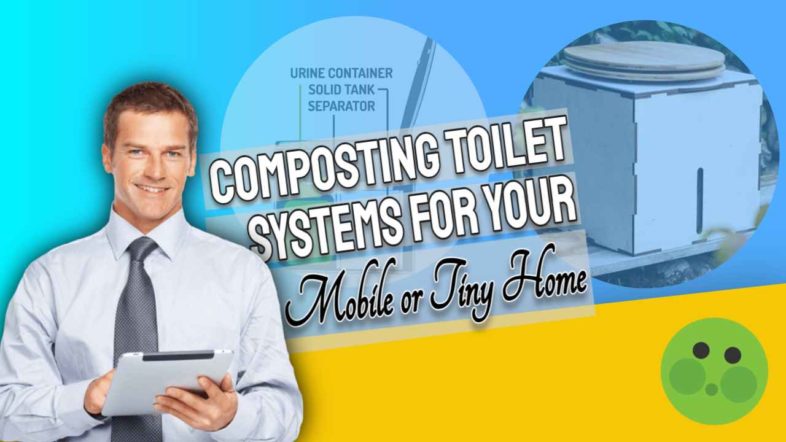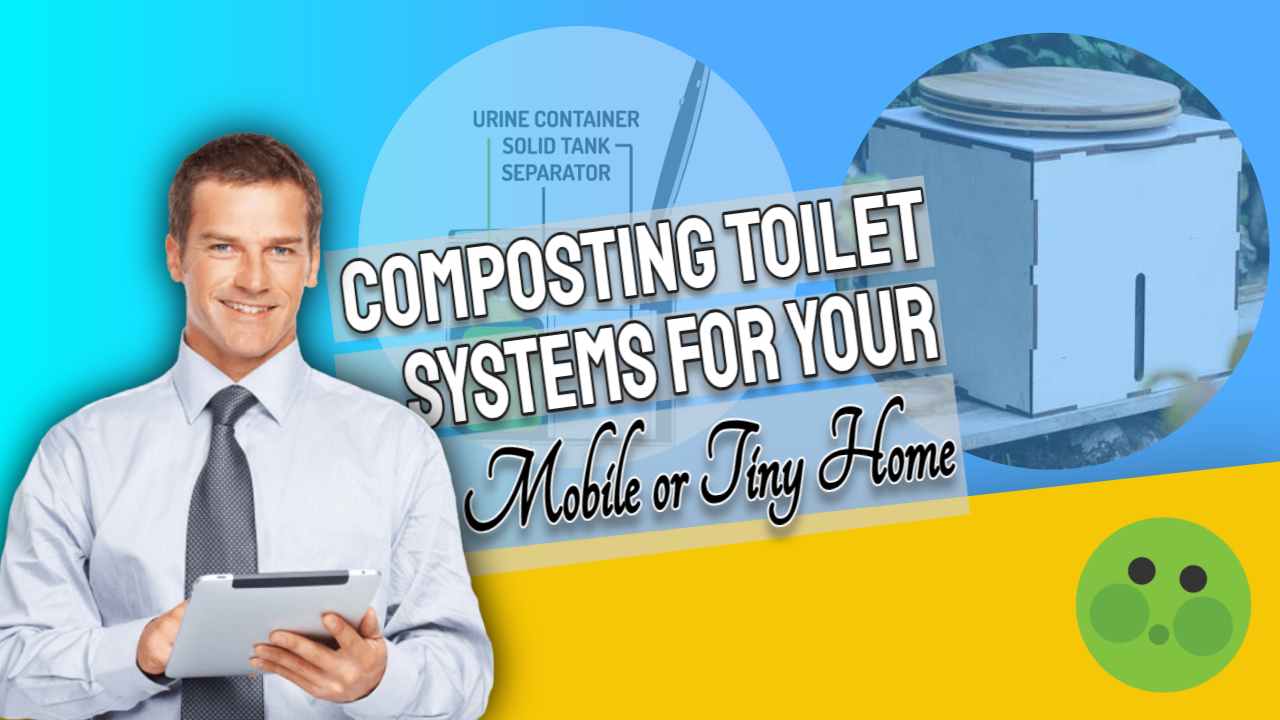In this article, we set out the information you will need to select the best composting toilet systems for Your mobile or tiny home on the move. Our criteria for the best choice in composting toilet systems are; compact, comfortable seat, degree of “odour free”, easy to use and empty, environmental materials used in construction, and environmental performance as both sustainability for future generations and the avoidance of pollution risk today.
Before you go on to read the more detailed information on this page we suggest that you watch the following video which explains the dry composting toilet system:
Composting Toilets for Your Mobile or Tiny Home
If your mobile home or tiny house lacks the plumbing to support a traditional flushing commode, a composting toilet could be the solution. This unusual kind of toilet uses aerobic bacteria to break down human waste and stows it in a neat, easy-to-remove package.
There are quite a few companies that make self-contained composting toilets. Sun-mar is ar popular brand. But, unfortunately, Sun-mar toilets take up more space and are said to be slightly more expensive than nature’s head. All these toilets are really designed to be used in a tiny home or cabin and generally these are for “homes on the move”.
Composting toilets are designed to fit in small spaces such as tiny homes, RVs, cabins, and a lot more. If you have one or more of these habitations mentioned, you will appreciate how a composting toilet does not take as much room as a regular one. Now to continue with our article. We hope you now appreciate that composting toilets are causing a splash in the world of eco-living!
Types of Composting Toilet Systems
The following isn't quite a buyers guide for marine composting toilets. First, we explain what exactly composting toilets are and how they work. Followed by the types, typical installations and general benefits of these types of toilets for your vessel.
Incinerating toilets are an interesting option. Rather than using biological processes to break down the waste over time, these types of toilets burn the solid waste inside of an incinerator, turning it into a sterile ash. Unlike composting toilets, incinerating toilets require a source of electricity as well as an exhaust pipe that runs through the roof.
There are designs that are being funded for development and one (the last one) already in production is a microwave toilet that transforms wastes into energy (funded by the Bill Gates Foundation).
Types Of Composting Toilets – Which Is Best For You?
Composting Toilet systems take on many guises such as:
- From the waterless models,
- to the dry flush systems, and
- the low flow types,
- but the main distinction is that there are two types of composting toilets – dry and wet.
In fact, nowadays we are spoilt for choice for this type of toilet.
All composting toilets require some media to mix with the solid waste. You can use many media types, including peat moss, coconut fibres, sawdust, woodchips, shredded leaves, and plenty of other mixing materials. However, sawdust is the most popular and inexpensive. It also works very well.
Compost toilets can be divided into types based on several different criteria. However, we believe it's easiest to think of the different types of toilets by first looking at how they process the waste, and then considering how they are built.
How Do Composting Toilets Work?
Many brands of composting toilets feature a tray or compartment that can be pulled out and emptied. Usually, there’s not as much need to empty them as much of the waste has dried to an inactive non-reacting cake, so you may be able to put it straight into your gardens or another compost pile.
Composting toilet guides are available that more fully describe the nature of composting toilet systems than we do here. Aspects to be considered are:
- how they work,
- how they are used,
- where they can be used,
- usage restrictions,
- and different composting toilet waste storage features
- fans and heaters to improve each composting toilet system's functionality.
Composting Humanure
The toilets are of two types – a self-contained kit with the composting unit being the part of the toilet, and another model where this unit is separate. The units are often fitted with a fan to remove the gas or foul odour emanating from the waste.
In composting toilet systems, there is often an unspoken participant which should be mentioned more often. Seldom on the sales pages for these dry toilet units is it mentioned that most people that own a composting toilet should also be pairing it with their own composting pile used in conjunction with heir composting toilet. We have already stated that composting toilets use microorganisms to decompose human waste mixed with wood shavings, lawn clippings and other organic matter into humus and they do that in home-composting piles or heaps.
What to Consider When Choosing the Best Composting Toilet
Now that we know what both incinerating toilets and composting toilets are, let’s talk about the main differences that you need to consider before choosing either of the two. There are up to seven major differences to consider:
- Wet or dry type.
- Aerobic or anaerobic design (most are aerobic but anaerobic brings the benefit of the biogas for cooking).
- Possible choice of incinerating toilet.
- Type of construction plastic moulding, or sustainable materials such as wood casings and seat.
- Physical size and tank storage capacity for the number of people who will be using the toilet system and, how long you seek between emptying depending, on usage.
- Basic model or model with added features such as a fan to ensure good air exchange and really low-odour potential. An electric heater is an optional extra for most models as well that may be needed for winter use.
- Disposal method for the collected human waste. Sewer discharge, dry composting with solids sent to a compost heap and dilute rime used for direct watering and fertilising your plants soil.
A lot of these decisions will for most people revolve around in principle deciding whether you are looking for a more convenient and less obviously environmentally damaging toileting method than a chemical toilet, or something green in its own right?
Don’t waste that waste—a top-notch composting toilet can put it to good use.
Now, we’re down to the things to consider when finding the best toilet for off-grid living, camping, recreational vehicle living or marine applications. Let’s discuss them and later be able to compare what you have to weigh when choosing the right composting toilet for your needs and situation.
We think that the best composting toilet systems for US buyers will be those from a company that meets the following requirements:
- offers a full range of composting toilets and bio options as well as dry flush toilets to suit any preference
- provides a product proudly made in the USA
- lightweight and compact designs including urine-diverting
- low odor/ odourless – even if that is thanks to incorporated venting systems!
- self-contained
- the ability to turn the waste when needed such as a crank handle stirrer system
- totally waterless operation and zero wastewater production
- separate tanks for solid and liquid waste and use as a fertilizer.
Separett™ AC/DC Composting Toilets
The Separett company supply a range of toilets they call “AC/DC” Composting Toilets”. These toilets work by evaporating liquid and controlling solid waste decomposition. This works best when urine and solid waste stay separate. And the brand name ‘Separett’ is a delightfully easy brand name to remember.
Testimonials for this sanitation product appear to be favourable (such as):
“I did a lot of research when looking for a composting toilet for the new rental house I was building on my property. I decided upon the Separett 9200 Villa that separates liquid waste from solid waste. It seemed to make sense that separating the solids from the liquids would increase the decomposition rate of the solid waste, keeping it drier as well, which in turn would decrease any unpleasant odours indoors.
The Separett Villa 9215 is an updated version of the company’s celebrated villa line of composting toilets. It’s designed to replicate the appearance and experience of a traditional flush toilet as much as possible. Unlike many other composting toilets, the villa looks a lot like a traditional toilet.
That model composting toilet system was introduced in 2018. This means that it is using some of the most current composting toilet technology. Therefore, it follows that the Separett Villa 9215 is going to be approved by many of the state health departments.
Nature’s Head Self Contained Composting Toilet
A composting toilet may be a great option as a portable toilet in the right situations. Many full-featured composting toilet systems are rather large to be considered a portable toilet. However, they can be used in a variety of situations where you need to have a toilet and regular plumbing is not an option.
Nature’s Head self-contained composting toilet is a very self-contained, compact toilet. Despite its small overall size, it still has an elongated comfort-sized seat. It uses no water to operate and has a urine separator (which typically needs emptying about every two days).
Reviews we read on these systems suggest that their best product was easily by a considerable margin Nature’s Head's self-contained composting toilet.
Reviews that feature hardware that is made entirely from stainless steel get good scores, as does:
- a design that easily disassembles for emptying and
- a full-size seat, which was found to be extremely comfortable.
Established in 2006, Nature’s Head is among the best composting toilet brands in the USA. Believe it or not, his brand was started by two long-term sailors who were in need of an eco-friendlier crapper for their use in the harsh marine environment.
We found the following testimonial:
“We bought our nature’s head composting toilet about 3 years ago. We’ve had plenty of time to discover the pros and cons of this unit and we’re going to share our experience with you today.
This is the only brand we’ve tried, but we’re currently renovating an airstream argosy and we plan to install an airhead composting toilet, to see what the difference is.”
Another company that produces composting toilets is the Kildwick company here.
Conclusion
A composting toilet system is a waterless toilet that utilizes natural decomposition and evaporation processes to get rid of human waste. These types of toilets are increasingly common at campgrounds and off-grid homes and cabins which don’t have access to running water.
Composting toilets are an exciting new development, especially for back-to-nature types.
However, they are not the only new toilet designs coming up.
Finally, finding the right RV composting toilet requires knowing what features make up these devices and deciding which you want to use in your own composting toilet system.
We hope that this article has helped to guide you through the essential variations and ensure you make a smart, responsible decision that reduces carbon emissions and is environmentally sustainable through helping to preserve our future life on this planet.
The Ultimate Guide to Cleaning Aquarium Rocks for a Healthy Fish Tank
Aquarium rocks are essential for creating a natural and visually appealing environment for fish and plants. However, they can also become a source of harmful bacteria, algae, and parasites if not cleaned regularly. Dirty rocks can lead to a variety of health issues for your aquatic pets, including fin rot, swim bladder disease, and even […]
What is Biogas?
The answer to the question, what is biogas? This environmentally friendly fuel is derived from anaerobic digestion (without oxygen). This process occurs in the presence of organic matter. In some environments, this organic matter is disposed of as livestock waste. In other locations, it is a waste water. There are many benefits of biogas for […]
How Can I Get Rich?
How can I get rich by making a lot of money? People who ask this question usually don't have much money to start with. They have a job that they can't afford to give up before they start making money. Most people don't have a lot of time to make a lot of money. At […]
Best iPhone Apps: How To Choose The Right Ones For Your Business
The best iPhone apps are an ideal way for users to access business information on the go. As mobile technology evolves, there are more ways than ever before for customers and businesses to interact with one another. There are tons of iPhone apps available for download, but there are only a few that really have […]









